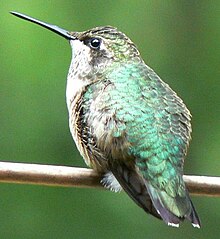
Hi Everybody!!
We had our first cold front this weekend (10-4/5-14) in my location of South Texas. My European friends will laugh to know the low was 64F! It was the coolest night since last March and very welcomed by the hot Texans. After the big herd of hummingbirds left on 9-22, another group came in on the 27th. These birds caught the north wind of the cold front and took off headed south. Only 10 birds remained yesterday and today, so I am going to declare the end of the Hummingbird Migration at the Kates Cabin Station. The good news is: the Migrations photos will continue here on the Blog with daily highlights from August 24 to October 5. The best is yet to come. (Stay tuned)- Enjoy!



Link to 8-23 Album:
https://plus.google.com/u/0/photos/117645114459863049265/albums/6064927992706944593








https://www.google.com/search?q=hummingbird+migration+route&biw=1440&bih=775&tbm=isch&tbo=u&source=univ&sa=X&ei=3fwxVM2KOdeBygTQ1YD4Dw&sqi=2&ved=0CCUQsAQ#facrc=_&imgdii=_&imgrc=N5Y14yFdqSCLCM%253A%3B8yRGdxlsVi37EM%3Bhttp%253A%252F%252Flyndagoff.com%252Fwp-content%252Fuploads%252F2014%252F01%252Fmigrationroutes.jpg%3Bhttp%253A%252F%252Flyndagoff.com%252Fsongbird-migration-across-the-gulf-of-mexico%252F%3B314%3B235
https://en.wikipedia.org/wiki/Hummingbird
Migration[edit]
Most hummingbirds of the U.S. and Canada migrate south in fall to spend winter in Mexico or Central America. A few southern South American species also move north to the tropics during the southern winter. A few species are year-round residents in the warmer coastal and southern desert regions of the USA. Among these are Anna's hummingbird, a common resident from California inland to Arizona and north to the southwestern coastal and south-central interior of British Columbia, and buff-bellied hummingbird, an uncommon resident in subtropical woodlands of southern Texas.
Ruby-throated hummingbirds migrate from as far north as all regions of Ontario south to Central America and Mexico via direct crossings of the Gulf of Mexico or coastal Texas.[57]
The rufous hummingbird is one of several species that breed in temperate western North America and winter in increasing numbers in the warm subtropical southeastern United States, rather than in tropical Mexico. By migrating in spring as far north as the Yukon or southern Alaska,[1] the rufous hummingbird nests farther north than any other hummingbird species and must tolerate occasional temperatures below freezing in its breeding territory. This cold hardiness enables it to survive temperatures below freezing, provided that adequate shelter and food are available.
The northward migration of rufous hummingbirds occurs along the Pacific flyway[1] and may be time-coordinated with flower and tree leaf emergence in spring in early March, and also with availability of insects as food.[58] Arrival at breeding grounds before nectar availability from mature flowers may jeopardize breeding opportunities, a factor of phenology possibly determining future migratory patterns linked to climate change.[59]
https://en.wikipedia.org/wiki/Ruby-throated_hummingbird
Habitat, range and migration[edit]
The breeding habitat is throughout most of eastern North America and the Canadian prairies, in deciduous and pine forests and forest edges, orchards, and gardens. The female builds a nest in a protected location in a shrub or a tree. Of all hummingbirds in the United States, this species has the largest breeding range.[5]
The ruby-throated hummingbird is migratory, spending most of the winter in southern Mexico and Central America,[9] as far south as extreme western Panama,[10] and the West Indies. During migration, some birds embark on a nonstop 600 mile journey across the Gulf of Mexico from Panama to Florida.[9] The bird breeds throughout the eastern United States, east of the 100th meridian, and in southern Canada, particularlyOntario, in eastern and mixed deciduous forest.[11][12] In winter, it is seen mostly in Mexico.

... this is brendasue signing off from Rainbow Creek. See you next time!

O+O



No comments:
Post a Comment